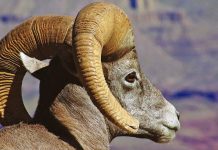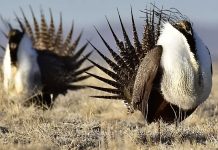SALT LAKE CITY, Utah, Jan. 23, 2023 (Gephardt Daily) — State wildlife officials want to remind the antler-gathering public it’s time to certify if you want to search during prime shed antler season.
“Collecting shed antlers from many big game species, including deer, elk and moose, is a popular pastime in Utah,” the state Division of Wildlife Resources notes on a press release.
“But before you head outdoors to collect shed antlers during the next few months, you are required to complete the Utah Division of Wildlife Resources’ Antler Gathering Ethics course.”
Some 20,000 Utahns complete the course each year, according to the DWR, meant to educate those who search antlers to do so without stressing wildlife already dealing with the challenges of winter, or damaging their habitat.
And the DWR advises hands-off if an antler is still attached to a skull — it’s probably poached and needs to be reported.
After dropping their antlers each winter, male deer, elk and moose will grow a new set of antlers starting in spring, the DWR said, and looking for those shed antlers is a fun activity that many Utah families enjoy.
“However, late winter and early spring are a tough time of year for deer, elk and moose, which is why the educational ethics course is required if you want to go ‘shed hunting’ between Feb. 1 and April 15.
“During winter, big game animals, especially deer, often have a difficult time finding food,” DWR Law Enforcement Capt. Chad Bettridge said. “As a result, they often survive on fat reserves they have built up prior to winter. If the animals are receiving constant pressure from people and repeatedly having to run or move, the animal has to use up those fat reserves and energy that it needs to make it through the winter.”
While there has been heavy snowfall this winter, shed hunting will still be allowed at this point, said the DWR, while noting the agency will continue to monitor winter conditions and will assess if a shed hunting closure is necessary.
“DWR conservation officers will also be adding additional patrols to ensure that people looking for antlers aren’t disturbing wintering wildlife. People who haven’t taken the mandatory Antler Gathering Ethics course or who are harassing protected wildlife may be cited.
Antler seekers can find the free course on the DWR website. “After you finish the course, you must print your certificate of completion and then carry it with you while you’re “shed hunting.” Completing the course is mandatory if you want to gather shed antlers from Feb. 1 through April 15, and the course must be completed each year.
Once the course is completed antler gathering can commence in many locations.
However, some notable exceptions include:
Wildlife management areas: Many of the state’s wildlife management areas are closed in the winter and spring to protect animals and their habitat. Make sure to double check for any closures before entering a WMA to gather shed antlers. You can find a list of Utah’s wildlife management areas and any seasonal closures on the DWR website.
Private property: You must have written permission from the landowner before gathering antlers on private land.
Native American lands, national parks and many national monuments are also closed to antler gathering.
If you find a skull with the antlers or horns still attached, it’s possible the animal was poached. Do not pick up or move the skull or disturb footprints or other evidence at the scene. Instead, please do the following:
Take photos of the skull from a couple of angles
Pinpoint the location of the skull (preferably using GPS coordinates)
Report your find to the nearest DWR office or by texting 847411
Provide specific details in your report
The DWR will send a conservation officer to investigate. If it’s clear the animal died of natural causes, you might be allowed to keep your find.
For more information about gathering shed antlers in Utah, call the nearest DWR office.






